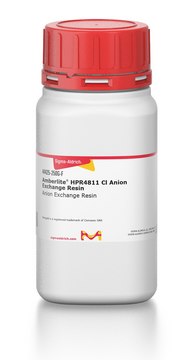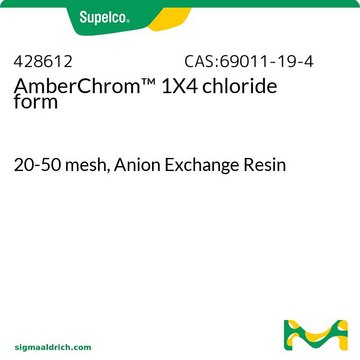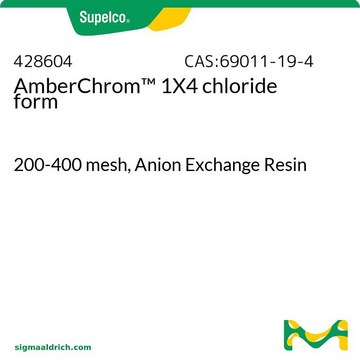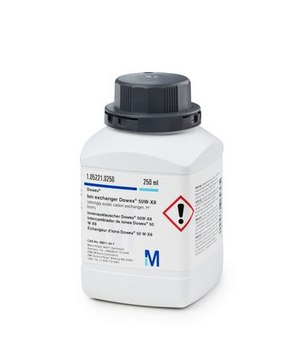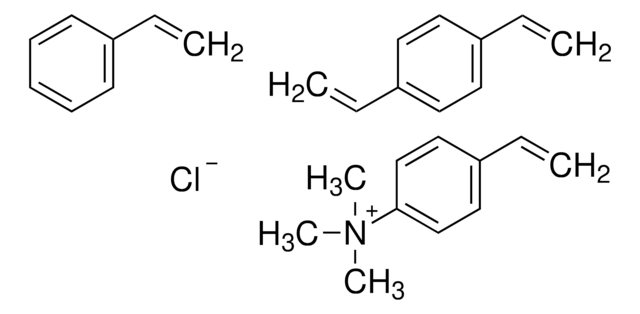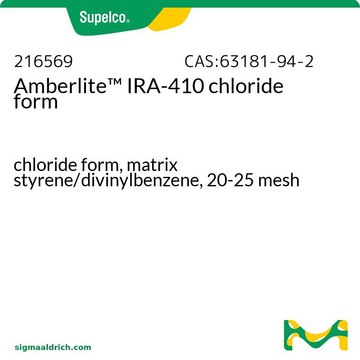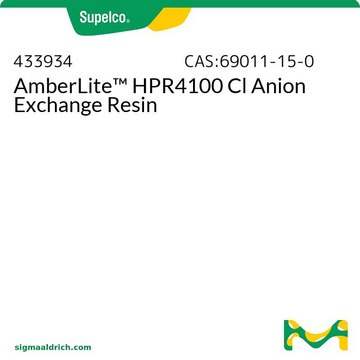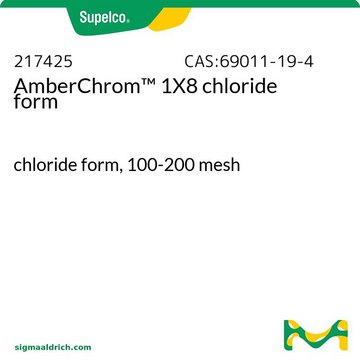217387
AmberChrom™ 1X2 Ion Exchange Resin
chloride form, 100-200 mesh
About This Item
Recommended Products
Product Name
AmberChrom™ 1X2 chloride form, 100-200 mesh
form
(Powder, Beads or Crystals)
Quality Level
crosslinking
2 % cross-linked
parameter
66 °C OH- form max. temp.
99 °C Cl- form max. temp.
moisture
70-80%
technique(s)
LPLC: suitable
matrix
styrene-divinylbenzene (gel)
matrix active group
trimethylbenzylammonium functional group
particle size
100-200 mesh
operating pH
0-14
capacity
0.7 meq/mL by wetted bed volume
separation technique
anion exchange
SMILES string
N(C)(C)C.C(C)c3c(cccc3)C=C.c2(c(cccc2)C=C)C=C.c1(ccccc1)C=C
InChI
1S/C10H12.C10H10.C8H8.C3H9N/c2*1-3-9-7-5-6-8-10(9)4-2;1-2-8-6-4-3-5-7-8;1-4(2)3/h3,5-8H,1,4H2,2H3;3-8H,1-2H2;2-7H,1H2;1-3H3
InChI key
HADXLRSCRPYPJJ-UHFFFAOYSA-N
Looking for similar products? Visit Product Comparison Guide
Related Categories
General description
Application
Features and Benefits
Other Notes
Legal Information
Storage Class Code
11 - Combustible Solids
WGK
WGK 2
Flash Point(F)
Not applicable
Flash Point(C)
Not applicable
Personal Protective Equipment
Choose from one of the most recent versions:
Certificates of Analysis (COA)
Don't see the Right Version?
If you require a particular version, you can look up a specific certificate by the Lot or Batch number.
Already Own This Product?
Find documentation for the products that you have recently purchased in the Document Library.
Which document(s) contains shelf-life or expiration date information for a given product?
If available for a given product, the recommended re-test date or the expiration date can be found on the Certificate of Analysis.
How do I get lot-specific information or a Certificate of Analysis?
The lot specific COA document can be found by entering the lot number above under the "Documents" section.
How do I find price and availability?
There are several ways to find pricing and availability for our products. Once you log onto our website, you will find the price and availability displayed on the product detail page. You can contact any of our Customer Sales and Service offices to receive a quote. USA customers: 1-800-325-3010 or view local office numbers.
What is the Department of Transportation shipping information for this product?
Transportation information can be found in Section 14 of the product's (M)SDS.To access the shipping information for this material, use the link on the product detail page for the product.
How can a Dowex type 1 resin in the chloride form be converted to the carbonate form?
As one might expect, the procedure requires the use of sodium carbonate (Na2CO3).Citation: Journal of Experimental Medicine, 120, 1007-1018 (1965).From page 1011 of that paper:"A 2 mL column of washed Dowex-1X8 200 to 400 mesh, in the chloride form, was converted to the carbonate form by washing with 1 M Na2CO3 until no chloride could be detected in the eluate. It was then washed with distilled water until the pH of the eluate reached neutrality". The simplest test for chloride is to use a dilute silver nitrate solution. If mixing a few drops of the eluate with a few drops of a silver nitrate solution results in a silver chloride precipitate forming, that would an indication that the eluate contains chloride. You could also use a chloride-specific electrode, if you have access to one.
My question is not addressed here, how can I contact Technical Service for assistance?
Ask a Scientist here.
Our team of scientists has experience in all areas of research including Life Science, Material Science, Chemical Synthesis, Chromatography, Analytical and many others.
Contact Technical Service